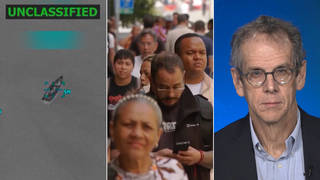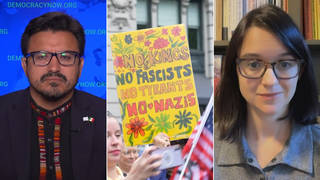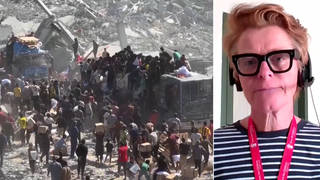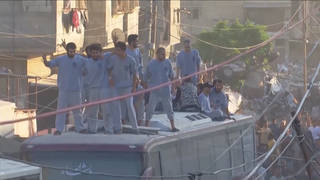
Guests
- Lorna Vassellmother of Saheed Vassell, an unarmed, mentally troubled African-American man shot in Brooklyn on April 5 by New York Police Department officers.
- Eric Vassellfather of Saheed Vassell, an unarmed, mentally troubled African-American man shot in Brooklyn on April 5 by New York Police Department officers.
Police officers responding to a 911 call shot dead an unarmed, mentally troubled African-American man on a street corner in Brooklyn on April 5. At the time of his death, Saheed Vassell was holding a metal pipe that police say they mistook for a gun. The NYPD said four officers—three in plainclothes and one uniformed—fired 10 rounds at Vassell, a Jamaican immigrant. None of the officers who opened fire were wearing body cameras. The Vassell family is now calling for the release of all unedited video from the area leading up to and during the shooting. We are joined by Saheed Vassell’s parents, Lorna and Eric Vassell.
Transcript
AMY GOODMAN: This is Democracy Now! I’m Amy Goodman. We end today’s show here in New York, where police officers responding to a 911 call shot dead an unarmed, mentally troubled African-American man on a street corner in Brooklyn April 5th. At the time of his death, Saheed Vassell was holding a metal pipe that police say they mistook for a gun. The NYPD says four officers—three in plainclothes, one uniformed—fired 10 rounds at Vassell, a Jamaican immigrant. Resident Kevin Davis witnessed the shooting by officers who arrived in an unmarked car, and described what he saw to New York Daily News reporter Edgar Sandoval.
KEVIN DAVIS: He walked across the street with the thing in his hand. The cops’ car was coming up the street. They take a U-turn. They came out of the car. They didn’t say, “Freeze.” They didn’t say, “Drop your weapon.” In two seconds, all four cops started shooting. They killed him.
EDGAR SANDOVAL: Was there like any exchange of words?
KEVIN DAVIS: No, no words. No words exchanged. Nothing.
EDGAR SANDOVAL: What went through your mind when you were seeing this?
KEVIN DAVIS: When I saw they come up and I saw them make the U-turn, I said to my friend, “Oh, damn. The cops.” I started to hold up my hands, trying to get their attention, to let them know that, you know, it’s nothing serious. In two seconds, they started shooting.
AMY GOODMAN: The New York State Attorney General’s Office is now investigating the fatal shooting. A recent study found the Crown Heights neighborhood of Brooklyn, where Saheed Vassell was killed, is one of the 20 most gentrified in the country. When over a thousand protesters gathered at the scene of his death, many longtime residents expressed concerns that 911 calls from new residents in the area have contributed to the criminalization of pre-existing, low-income residents of color, especially black men.
At first, the NYPD released edited surveillance video of Vassell’s actions prior to his death. Then, after pressure, they released video showing the cops shooting Vassell. None of the officers who opened fire were wearing body cameras. The Vassell family is now calling for the release of all unedited video from the area leading up to and during the shooting.
For more, we’re joined by Saheed Vassell’s parents, Lorna and Eric Vassell.
We welcome you both to Democracy Now! And our condolences on the death of your son.
LORNA VASSELL: Thank you.
ERIC VASSELL: Thank you.
AMY GOODMAN: Can you explain to people what you understood happened? And where were you at the time, Eric Vassell?
ERIC VASSELL: I was home at the time, when I hear a knocking on my door. I thought it was my son coming in, because he always come home at that time. Then I hear my other son say to me, “Dad, they just shot Saheed.” I said, “Who shot him?” He said, “The police shot him.” And he went away. I began to cry. I cried until I heard the door open. It was my son who entered by the door. I said, “What happened to the young man?” He said, “Dad, he died.” And I stopped crying. And I just sat there in awe. After a while, I went to call my wife. I didn’t get her. I waited for another time. I called her back, and I told her that Saheed met in an accident. And she said, “OK,” she will call me back. And I just stayed there, wondering about, you know, how my wife is going to take this tragic news, to hear that her son, who is my son, had just died.
AMY GOODMAN: Lorna Vassell, how old was Saheed?
LORNA VASSELL: Saheed is 34 years old.
AMY GOODMAN: And talk about what you understand happened.
LORNA VASSELL: I understand that Saheed was on the street playing around with his friends. He left, going to the store. And then he was going to the store. I get to understand that as he enter between Montgomery and Utica Avenue, a unmarked police car just turned around, and they did not ask him any question. They just started to fire all those shots on him. One of the guys said when he ran to stop the police, to say, “No, he is an innocent person,” he said they have already killed him. That’s all I get to hear about my son.
AMY GOODMAN: Saheed Vassell, your son, apparently, as we have been covering this, slid into a downward spiral after the police killed his friend, Ortanzso (Marlon) Bovell?
LORNA VASSELL: Yes.
AMY GOODMAN: In 2008, relatives and friends confirmed on Saturday. Is that right?
LORNA VASSELL: Yes.
AMY GOODMAN: And so, talk about his mental state and what the police are saying.
LORNA VASSELL: Saheed diagnosed, couple years after his friend died, that he had bipolar. I try—I got help for him. He did not want to take the medication. He said the medication was doing him worse. But Saheed would do the best he could. He just normal, do everything the same way, come in, in and out, take a shower, eat his food, loved to joke around. He would joke around in the house, and he just left. He was not a violent person. He was—
AMY GOODMAN: Well known in the community?
LORNA VASSELL: He was known in the community to everyone. He was such a loving person. He just loved to be funny, dance around. You go out the street, you would see Saheed. Even one day I was going to work, I saw Saheed and a police officer on the street. I went up and said, “Officer, everything is OK?” He said, “Yes, that’s a wonderful young man. I know him here. He’s good. That’s a good kid.” And I said, “OK, thank you,” and I went to work. Saheed was not a violent person. In no way he was violent.
AMY GOODMAN: You went with your son, Eric Vassell, to church a lot of mornings?
ERIC VASSELL: Yes. He used to accompany to church on Saturday. You know, he didn’t stay for the whole-day service. He’d just come in the morning, and after the midday service, Saheed would go home. You know, I loved the young man, because—my wife always say he looked like me. He’s a wonderful young man, never gave any trouble on the street. And he was loved by everyone.
AMY GOODMAN: Saheed was diagnosed as bipolar?
ERIC VASSELL: Yes, he did, diagnosed bipolar. But diagnosed bipolar, I, as a parent, was turned away by the city, because the city said I could not be responsible for him anymore, because he was of age. So, the city took him, abandoned him, then the police shot him.
AMY GOODMAN: I want to turn to the New York Police Chief Terence Monahan answering reporters’ questions about the police killing of your son Saheed, when he was asked about him being bipolar. The four officers who responded to the 911 calls about his behavior were not specially trained to interact with emotionally disturbed people.
POLICE CHIEF TERENCE MONAHAN: This was not an EDP call. This was not an emotionally disturbed call. This was a call of a man pointing what 911 callers and people felt was a gun at people on the street. When we encounter him, he turns, with what appears to be a gun, at the officers.
AMY GOODMAN: So, during a radio interview with Brian Lehrer on WNYC, New York City Mayor Bill de Blasio was asked why he would not release the names of the police officers who killed Saheed or more video of the shooting. This is the mayor.
MAYOR BILL DE BLASIO: I believe the way we’re doing it, this way, is right, because there’s both an internal investigation and an independent investigation. But we’re also mindful of protecting everyone involved, and we don’t want a situation where the names of the officers are out there. I don’t think it’s productive. Later on, when there is a follow-through on the process, you know, that’s when names come out appropriately.
But the bottom line here is, the transcripts have been put out of the 911 calls, the video has been put out. All video that we have and that we continue to get will be put out once the attorney general signs off on its release. And that’s been the case previously with body camera footage in situations like this, as well. And there’s going to be a full process here to find out the truth. I spoke to Mr. Vassell, the father of Saheed, and he said to me the one thing he hopes will happen at the end of this process is that the truth comes out and justice is served, whatever that is. And I said I am absolutely committed to that, and I know the attorney general is, as well.
AMY GOODMAN: So that was New York Mayor Bill de Blasio saying the video of police shooting Saheed was withheld because the New York Attorney General’s Office prevented its release during its investigation. But a press secretary for the New York Attorney General Eric Schneiderman said in a statement, “Our office played no role in the N.Y.P.D.'s decision to release partial footage concerning the Vassell case last week, and we have not objected to the N.Y.P.D.'s release of video footage of the officers.” Eric Vassell, if you can respond? You spoke to the mayor?
ERIC VASSELL: Yes, I spoke to the mayor. I told the mayor that I need justice to be served. But what the mayor is saying, that they won’t release, you know, any video of the officers, I say that that’s a double standard, because if the video and pictures of my son can be released and sent all across the world, therefore, just like when they released my son’s pictures and videos across the world, they should release every video and action of the police, because in a further statement they say that he pointed the thing at them. I would always say a picture is worth a thousand words. So, if he did have an object in his hand, they should show him pointing that object at the police. That’s the picture I am looking for.
AMY GOODMAN: They’ve only shown him in this menacing position holding this bar, but there is obviously—clearly, commercial area—there’s lots of video that you could see. This is somewhat reminiscent of Tamir Rice, where, within seconds of them arriving, they shot him.
LORNA VASSELL: They shot him.
ERIC VASSELL: They shot him. And I’m saying, if—I’m saying that if, as a police officer, if the 911 call that comes in, what are the protocols that the police took to apprehend someone with a gun, someone who was mentally challenged? Because I know if they say that there is a hostage crisis somewhere, there are protocol. If they say there is a man on the Brooklyn Bridge who wanted to commit suicide, there is a protocol to approach it. If they say that there’s a mental person with a gun or that person have a gun, there have to be some protocol there.
AMY GOODMAN: And, of course, he didn’t have a gun. He held a metal bar that looked like a shower head.
ERIC VASSELL: That’s what they say. That’s what they say: He have something in his hand that looked like a shower head. That’s what they say.
AMY GOODMAN: We have to leave it here, but we will continue to investigate this case. Lorna and Eric Vassell have lost their son, killed by New York police earlier this month.











Media Options